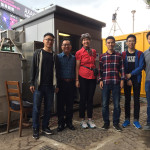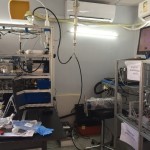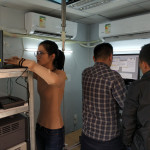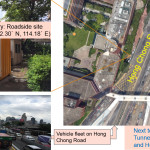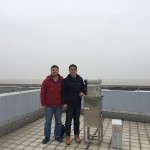- Professor Lidia Morawska visited the sampling site at the Cross-harbor Tunnel in Hong Kong (from left to right: Mr. Xiaopu Lyu, Prof Hai Guo, Prof. Lidia Morawska, Dr. Tengyu Liu, Mr. Haoxian Lu and Mr. Dawen Yao). Lidia Morawska教授参观了香港海底隧道的抽样点(从左至右:吕效谱先生,郭海教授,Lidia Morawska教授,刘丹宇博士,陆浩贤先生,姚大文先生
- A variety of state-of-the-art instruments were in operation during the sampling campaign. 在采样活动期间,各种最先进的仪器正在运行
- A variety of state-of-the-art instruments were in operation during the sampling campaign. 在采样活动期间,各种最先进的仪器正在运行
- Sampling sites. 采样地点
- Professor Yingjun Chen guided a research student to conduct sampling campaign at a rural site in Shanghai. 陈颖军教授指导研究生在上海的一个农村地区进行采样活动
The Hong Kong and Shanghai Winter Sampling Campaign was carried out at the Hong Kong Cross-harbor Tunnel and two sites in Shanghai simultaneously, led by Professor Hai Guo from Hong Kong Polytechnic University. The project focused on the measurement of emission characteristics, chemical transformation, and impacts on regional air quality of urban plumes from four major population centres in Brisbane, Singapore and China with different energy use and/or meteorology. This was a joint project between Professor Lidia Morawska from Queensland University of Technology, Professor Raj Bala from National University of Singapore, Professor Yingjun Chen from Tongji University, and Professor Hai Guo from the Hong Kong Polytechnic University, and was funded by the Asian Universities Cluster Centre of Excellence in Civil Engineering.
The measurements included canister sampling for volatile organic compounds (VOCs), DNPH cartridges for carbonyl compounds, real-time monitoring of weather conditions, trace gases and VOCs, SMPS for particle number concentrations and new particle formation, NAIS for sampling of 2-5 nm particles, as well as the first commercialized Thermal-Desorption Aerosol Gas-chromatograph (TAG-GC)-Time of Flight (ToF)-Mass Spectrometer (MS) for organic species in aerosols, and High-Resolution-ToF-Aerosol Mass Spectrometer (HR-ToF-AMS) for total organics, sulphates, nitrates, ammonium and chloride in aerosols. More than 20 research students and researchers participated in the sampling campaigns. This will be followed by a comprehensive analysis of the chemical database using a combination of statistical analysis of field observations, mesoscale meteorological simulations, diagnostic and prognostic box models, for example, an observation-based box model, an emission-based model, and chemical transport models. The data collected will significantly improve our understanding of photochemical formation of ozone (O3) and secondary organic aerosols (SOA), and their transport mechanisms in different regions with complex interaction of meteorology and chemistry. The scientific findings will have direct policy implications for reducing O3 and SOA pollution and visibility degradation in the four different population centres. This campaign is a part of the project “Comparative study of emission, transformation and effects of urban pollution from Australia, Singapore, Shanghai and Hong Kong”. Up to now, three high-quality journal papers were generated from this project and more are in preparation for submission in 2018.
从2017年11月 – 2018年2月,在香港和上海的冬季采样运动
香港和上海冬季采样活动在香港理工大学海郭教授的领导下,在香港过海隧道和上海的两个地点同时进行。该项目侧重于测量布里斯班,新加坡和中国四个主要人口中心在不同能源使用和气象情况下的排放特征,化学转化以及对城市羽流区域空气质量的影响。这是昆士兰科技大学的Lidia Morawska教授,新加坡国立大学的Raj Bala教授,复旦大学的陈颖军教授和香港理工大学的郭海教授的一个联合项目,由亚洲大学集群土木工程卓越中心出资。
这些测量包括挥发性有机化合物(VOCs)罐式采样,羰基化合物DNPH筒,实时监测天气状况,痕量气体和挥发性有机化合物,粒子数浓度和新粒子形成的扫描电迁移率颗粒物粒径,NAIS用于取样2-5纳米的颗粒,以及第一个商业化的热解吸气溶胶气相色谱仪(TAG-GC) – 飞行时间(ToF) – 质谱仪(MS),用于测定气溶胶中的有机物,以及用高分辨率气溶胶质谱HR-ToF-AMS)来测定气溶胶中的总有机物,硫酸盐,硝酸盐,铵和氯化物。 20多名研究学生和研究人员参加了采样活动。随后将综合现场观测的统计分析,中尺度气象模拟,诊断和预测盒模型(例如基于观测的盒模型,基于排放的模型和化学传输模型),对化学数据库进行全面分析。收集的数据将显着提高我们对臭氧(O3)和二次有机气溶胶(SOA)的光化学形成,以及它们在气象和化学复杂相互作用下的在不同地区的传输机制的理解。科学发现将对减少四个不同人口中心的O3和SOA污染和能见度降低产生直接的政策影响。这项运动是“澳大利亚,新加坡,上海和香港城市污染排放,转化和影响的比较研究”项目的一部分。截至目前,该项目已产生三篇高质量的期刊论文,并有更多正在准备于2018年提交。

